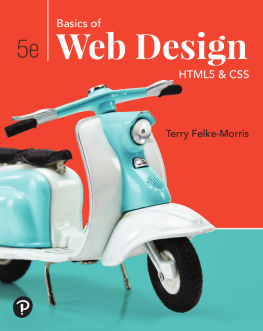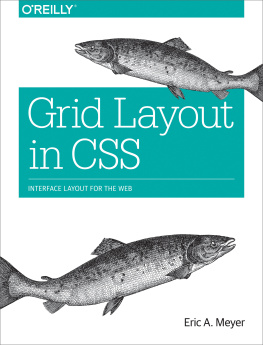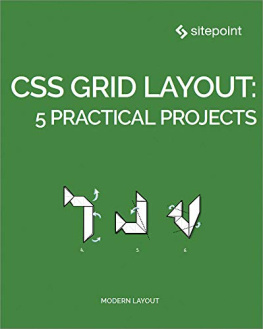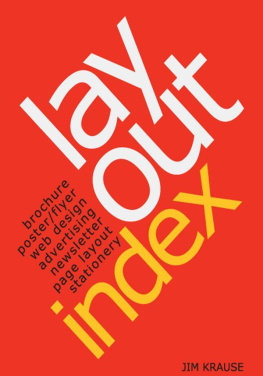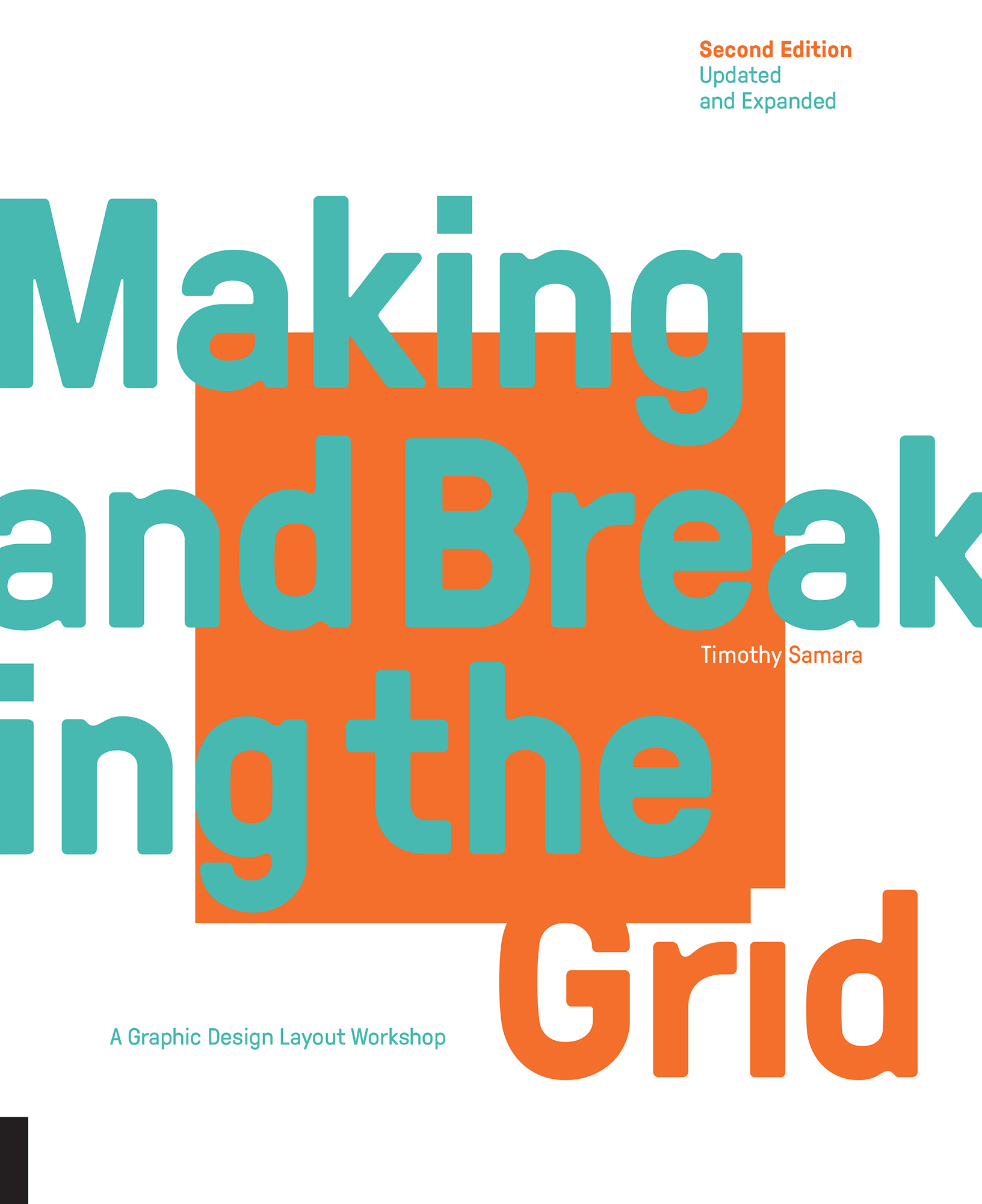A Graphic Design Layout Workshop
Second Edition Updated and Expanded
Timothy Samara

Thoughts on Structure
An Introduction
For some graphic designers, it has become an unquestioned part of the working process that yields precision, order, and clarity.
For others, it is symbolic of Old Guard aesthetic oppression, a stifling cage that hinders the search for expression.
The typographic grid is an organizing principle in graphic design whose influence is simultaneously ingrained in current practice and fought over in design education, revered and reviled for the absolutes inherent in its conception. It is a principle with roots in the cultural practices of the oldest societies on the planet. Eking out an existence with some kind of meaningand creating an understandable order for that meaningis one of the activities that distinguishes our species from all others.
___ Structural thinking, even before its latest codification through European and American Modernism, has been a hallmark of cultures struggling toward civilization. The Chinese, the Japanese, the Greeks and Romans, the Incaall of these cultures have pursued structural ideas in laying out their towns, conducting warfare, instituting religious rituals, arranging images. In many instances, that structure was predicated on the notion of intersecting axes that corresponded to the intersection of sky and earth.
___ The grid instituted by Modernism restated that long-ingrained sense of order, formalizing it yet another degree and transforming it into an established part of design. The typographic grida fundamental tenet of the International Styleis an orthogonal planning system that parcels information into manageable chunks. The assumption of this system is that placement and scale relationships between informational elementswhether words or imageshelp an audience understand their meaning. Like items are arranged in similar ways so that their similarities are made more apparent and, therefore, more recognizable. The grid renders the elements it controls into a neutral spatial field of regularity that permits accessibilityviewers know where to locate information they seek because the junctures of horizontal and vertical divisions act as signposts for locating that information. The system helps viewers understand its use. In one sense, the grid is like a visual filing cabinet.
___ As an institutionalized metaphor for all that is right in the worldthe intersection of heaven and earth made manifest in every object it governsthe grid has also been imbued with an explicitly spiritual quality. Its early proponents among the European avant-garde fought zealously on its behalf: Theo van Doesburgs mere tilting of the 90 de Stijl axis caused his partner, Piet Mondrian, to sever ties; Josef Mller-Brockmann, the grids Swiss champion in the 1950s and 1960s, defined its will to order in nearly canonical terms.
___ For the graphic designers who helped society struggle to move forward after two unimaginable wars, order and clarity became their most important goals. Part of that order, of course, meant consumer comforts; and the businesses that provided them recognized soon enough that the grid could help organize their public presence and their bottom lines.
___ As the use of grids has changed from self-conscious gesture to that of second-nature reflex, so, too, has the viewing public become more accustomed to information presented to them in greater quantities, simultaneously, in greater complexity, and in more languages. And theyre not simply accustomed to it: they want it that way. The grids minimal simplicity is somewhat at odds with the kinetic, shifting surface of multi media; information isnt flat anymore, and the average person expects it to move, jump, twist, and make noise. Paradoxically, the corporations that clothed themselves in the grids neutral, utopian uniform helped create the oversaturated environment that is currently in demand.
___ Recent years have seen the design profession, its activities, and design thinking, come to the forefront of public consciousness; its become an especially important discipline for the information age. Within the design community, discussions of accessibility, gender, race, and other social concerns are given greater priority than the intrinsic relationships between form, organization, and meaning; its hard to find that kind of discussion in the design industry any more. Given that form making and its organization are inextricably linked to the visual dissemination of information, however, it seems likely that this simple-seeming discussion could really be a bit more complex, perhaps even wrapping these same bigger issues that graphic designers have been giving more attention... an aesthetic unconscious of sorts weve decided to ignore without realizing its fundamental hegemony.
___ The current era is a little bit like that of Victorian England during the first Industrial Revolution, in the sense that were living through another paradigmatic shift in technology and culture: Our appliances talk to us, our vision is global. The worlds vast space has been reduced metaphorically as well as physically, and were learning to cope with an uncomfortable intimacy as the private self recedes and resources dwindle. Our own industrial revolutions similarity to its antecedent continues, not unexpectedly, in its influence on the arts. A plurality of oft conflicting approaches reflects the general cultural confusion that has pervaded the beginning of this millennium.
___ Interestingly, since the publication of this books first edition in 2003, grid use has become remarkably prevalent, ostensibly driven by the practical demands of responsive UX design in a world increasingly linked by online communication. It may also reflect a renewed urge for cultural unity in response to that early millenial confusion. Simplicity, order, and visual neutrality in communication are, historically, strategies aimed at facilitating inclusivity... But they also pose a potential threat through the aesthetic (and, arguably, intellectual) conformity they engender: designers need only consider the ubiquity of similarly templated, almost interchangeable, websites and branded communication programs in current proliferation to appreciate that efficiencies in organization and production can also render an experiential landscape that is repetitve, undifferentiated, and mind-numbingly dull.
___ Given ongoing discussions about identity, the individuals relationship to society at large, and our responsibilities to each other and our shared environment, conversations about where to put thingsthe mundane housekeeping of grid-based designstill have value, but so too do those concerned with imagining ways of connecting with each other through visual languages that are unexpected, unconventional, and uniquely expressive. Information comes in many varieties, not the least of which are the symbolic, metaphorical, and emotional; effiicient transmission need not be the only concern and, quite often, inefficiency in the visualization of information results in an audiences deeper understanding of a message by virtue of the challenges it asks them to overcome.
___ Ultimately, it is incumbent upon designers to evaluate the many options for constructing a visual communication they have before themgrid-based and otherwiseand to choose that which allows them to build the most thoughtful, useful, and meaningful experiences for their audiences that they can envision.



